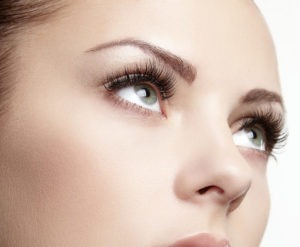
Model, not actual patient.
Benign essential blepharospasm refers to a condition characterized by spasms of the eyelids or abnormal blinking. This condition is a form of dystonia, which is a group of movement disorders involving involuntary tensing of the muscles (muscle contractions), rhythmic shaking (tremors), and other uncontrolled movements.
Benign essential blepharospasm is distinct from the common, temporary eye twitching that may occur due to stress, fatigue, or caffeine. Eventually, patients with this condition may not be able to drive, read, or undertake routine daily tasks as they cannot open their eyes properly.
Khan Eyelid and Facial Aesthetics, led by board certified ophthalmologist Dr. Tanya Khan, provides safe and proven eye care procedures to patients in Plano, Dallas, Texas, and surrounding locations.
Symptoms
Benign essential blepharospasm signs and symptoms typically appear in mid to late adulthood and slowly worsen. The initial symptoms of the condition include dry eyes, an increased frequency of blinking, and eye irritation that is made worse by air pollution, wind, sunlight, and other irritants. These symptoms may initiate in one eye but ultimately impact both eyes.
Upon progressing, the condition may cause spasms of the muscles around the eyes, leading to uncontrolled squinting and winking. People affected by this condition find it increasingly hard to keep their eyes open, which can cause severe vision impairment.
Over 50 percent of all people with benign essential blepharospasm experience the spread of dystonia beyond the eyes to impact other facial muscles and muscles in other body areas.
Causes
The reasons for the occurrence of benign essential blepharospasm are not known, but the condition likely results from a combination of environmental and genetic factors. Some genetic changes probably increase the chances of developing this disorder, and environmental factors may trigger the symptoms in at-risk individuals.
How is Blepharospasm Detected?
A physician (usually an ophthalmologist) undertakes a clinical assessment to diagnose blepharospasm. At times, it may be challenging to diagnose. It is usually necessary for the physician to assess information taken from the patient, and the neurological and physical exam to offer the diagnosis. Electrodiagnosis is a vital tool in the diagnosis of blepharospasm.
Treatment
The first line of treatment for the diagnosis of blepharospasm is periodic Botox injections. Botox is a robust drug that obstructs the signals between facial muscles and nerves.
It is injected into strategic areas in the forehead and eyelids. Botox can greatly minimize or resolve spasms. However, the patient may need to undergo repetitive treatments every three to four months, as the effects of the medication are temporary.
Botox may not be effective for some patients or have a diminishing response over a span of time. If this is the case, and the spasms lead to significant disruption, then the doctor may recommend surgical myectomy to the patient.
A surgical myectomy involves the surgical excision of some or all of the orbicularis oculi muscle in the upper lids, which is the muscle that allows the lids to shut. This procedure has been proven to greatly improve blepharospasms. The risks include incomplete eyelid closure, and post-op inflammation and bruising.
In case there is any sagginess of the upper lids or excess upper eyelid skin, upper eyelid blepharoplasty or ptosis repair may help improve visual impairment. These procedures may also be performed in combination with a partial surgical myectomy.
Current research indicates that myectomy has improved visual disability in 75 to 80 percent of cases of blepharospasm. Oculoplastic & reconstructive surgeon Dr. Tanya Khan receives patients from Plano, Dallas, Texas, and nearby areas for advanced eye care procedures.
Contact Khan Eyelid and Facial Aesthetics and Oculoplastic & Reconstructive Surgeon Dr. Tanya Khan Today to Schedule an Appointment
For more information about procedures and treatments at Khan Eyelid and Facial Aesthetics by Ophthalmic surgeon Dr. Tanya Khan. Click here to contact us.
Taking patients from in and around Dallas, Plano, Fort Worth, Grapevine, Garland, Mesquite, Carrollton, Irving, Frisco, Texas and more.









Schedule a Consultation: 972-EYE-LIDS (393-5437)